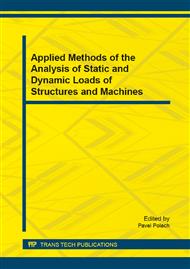[1]
E. Tazawa, Effect of self-stress on flexural strength of gypsum–polymer composites, Advanced Cement Based Materials 7 (1998) 1-7.
DOI: 10.1016/s1065-7355(97)00010-2
Google Scholar
[2]
T. Plachý, P. Tesárek, R. Ťoupek, M. Polák, Nondestructive Determination of Young's Modulus of Gypsum Specimens Using Impulse Excitation Method, in: P. Šmíd, P. Horváth, M. Hrabovský (Eds. ), Proceedings of 48th International Scientific Conference Experimental Stress Analysis 2010, Palacky University, Olomouc, Velké Losiny, 2010, pp.339-344.
Google Scholar
[3]
P. Padevet, P. Tesarek, T. Plachy, Evolution of mechanical properties of gypsum in time. International Journal of Mechanics 1 (2011) 1-9.
Google Scholar
[4]
T. Plachý, P. Tesárek, A. Wilczynska, P. Padevět, Experiment in real conditions: Mechanical properties of gypsum block determined using non-destructive and destructive methods, in: Proceedings of the 3rd WSEAS International Conference on Engineering Mechanics, Structures, Engineering Geology EMESEG 10 and the International Conference on Geography and Geology 2010 WORLDGEO , 10, Corfu Island, 2010, pp.418-423.
Google Scholar
[5]
ASTM C215, Standard Test Method for Fundamental Transverse, Longitudinal, and Torsional Resonant Frequencies of Concrete Specimens, Annual Book of ASTM Standards, American Society for Testing and Materials, (1991).
DOI: 10.1520/c0215-02
Google Scholar
[6]
ASTM E1876-01, Standard Test Method for Dynamic Young's Modulus, Shear Modulus, and Poisson's Ratio by Impulse Excitation of Vibration, Annual Book of ASTM Standards, American Society for Testing and Materials, (2006).
DOI: 10.1520/c1548
Google Scholar
[7]
L. Melzerová, M. Šejnoha, Interpretation of results of penetration tests performed on timber structures in bending, Applied Mechanics and Materials 486 (2014) 347-352.
DOI: 10.4028/www.scientific.net/amm.486.347
Google Scholar
[8]
P. Padevět, R. Lovichová, The changes of material properties oft he cement paste with fly ash exposed to high temperatures, WSEAS Transactions on Applied and Theoretical Mechanics 8 (2014) 304-312.
DOI: 10.4028/www.scientific.net/amr.742.187
Google Scholar
[9]
P. Tesárek, J. Němeček, Microstructures and micro-mechanical study of gypsum, Chemicke listy 105 (2011) 852-853.
Google Scholar
[10]
P. Tesárek, T. Plachý, P. Ryparová, J. Němeček, Micromechanical properties of different materials on gypsum basis, Chemicke Listy 106 (Issue SUPPL. 3) (2012) s547-s548.
Google Scholar


